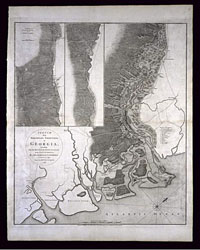Georgia

In 1732, James Oglethorpe and 20 trustees were granted a proprietorship carved out of South Carolina by George II to provide a buffer of white settlers against the Spanish in Florida and the slave society in South Carolina. It was also something of an experiment in egalitarianism: slavery was initially forbidden, the proprietors were banned from taking any profits, it would be a refuge for debtors and protestants fleeing from elsewhere, and each male settler would receive 50 acres of land and the tools to work it. The trustees also banned the consumption of alcoholic beverages. Moreover, it was the only colony in which parliament invested heavily to foster population growth. Shortly after settlers began to arrive, however, significant changes were made to the trustees' plans. The ban on slavery, for example, was revoked in 1750 and the colony turned over to the crown in 1751.





